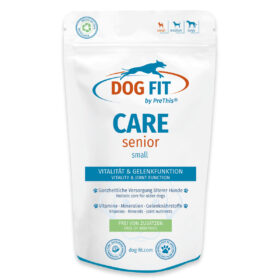Hyaluronic acid for dogs
Hyaluronic acid: Support for joints, intervertebral discs, skin and tissue
Hyaluronic acid is a natural component of connective tissue and belongs to the group of glycosaminoglycans. It is particularly known for its ability to bind large amounts of water – a property that makes it indispensable in many areas of the organism. In dogs, too, hyaluronic acid plays an important role in maintaining the normal function of joints, intervertebral discs, skin, tissue, and metabolism.
Water binding and pressure buffering
In the joint and vertebral area, hyaluronic acid is a component of synovial fluid – the synovial fluid. This helps reduce friction between the joint surfaces and enables smooth movement. At the same time, the water-binding properties of hyaluronic acid ensure that the joint cartilage remains elastic and can perform its natural buffering function. Hyaluronic acid also plays a physiological role in the intervertebral discs – where it supports pressure distribution and stability.
For skin, tissue, and metabolic processes
In addition to the musculoskeletal system, hyaluronic acid also fulfills important functions for the skin and connective tissue. It contributes to moisture balance and supports natural cell structure. Hyaluronic acid is also often used in conjunction with a balanced diet to support physiological metabolic processes in the tissue – especially in older dogs or when the organism has special requirements.
High-quality hyaluronic acid
In our supplementary food for senior dogs DOG FIT by PreThis® CARE senior, hyaluronic acid is used in carefully calibrated doses. The formula combines other valuable micronutrients to support the needs-based nutrition of older dogs – in keeping with a holistic approach. The formula is, of course, free of artificial additives.
5% discount for new customers: DOGFIT

